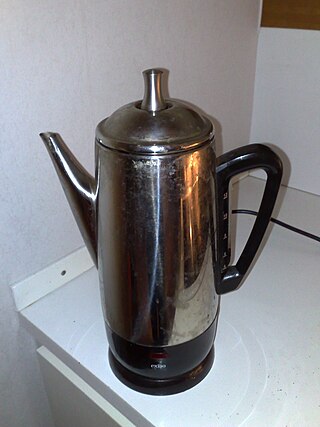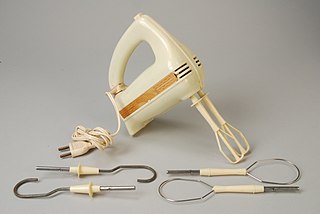
A teapot is a vessel used for steeping tea leaves or a herbal mix in boiling or near-boiling water, and for serving the resulting infusion which is called tea. It is one of the core components of teaware. Dry tea is available either in tea bags or as loose tea, in which case a tea infuser or tea strainer may be of some assistance, either to hold the leaves as they steep or to catch the leaves inside the teapot when the tea is poured. Teapots usually have an opening with a lid at their top, where the dry tea and hot water are added, a handle for holding by hand and a spout through which the tea is served. Some teapots have a strainer built-in on the inner edge of the spout. A small air hole in the lid is often created to stop the spout from dripping and splashing when tea is poured. In modern times, a thermally insulating cover called a tea cosy may be used to enhance the steeping process or to prevent the contents of the teapot from cooling too rapidly.

A coffee percolator is a type of pot used for the brewing of coffee by continually cycling the boiling or nearly boiling brew through the grounds using gravity until the required strength is reached. The grounds are held in a perforated metal filter basket.

A samovar is a metal container traditionally used to heat and boil water. Although originating in Russia, the samovar is well known outside of Russia and has spread through Russian culture to other parts of Eastern Europe, as well as Western and Central and South Asia. Since the heated water is typically used to make tea, many samovars have a ring-shaped attachment around the chimney to hold and heat a teapot filled with tea concentrate. Though traditionally heated with coal or kindling, many newer samovars use electricity to heat water in a manner similar to an electric water boiler. Antique samovars are often prized for their beautiful workmanship.

A tea infuser is a device in which loose, dried tea leaves are placed for steeping or brewing, in a mug or a teapot full of hot water; it is often called a teaball or tea maker, and sometimes a tea egg. The tea infuser gained popularity in the first half of the 19th century. Tea infusers enable one to easily steep tea from fannings and broken leaf teas.

A kettle, sometimes called a tea kettle or teakettle, is a device specialized for boiling water, commonly with a lid, spout, and handle. There are two main types: the stovetop kettle, which uses heat from a hob, and the electric kettle, which is a small kitchen appliance with an internal heating element.

An alarm clock or alarm is a clock that is designed to alert an individual or group of people at a specified time. The primary function of these clocks is to awaken people from their night's sleep or short naps; they can sometimes be used for other reminders as well. Most alarm clocks make sounds; some make light or vibration. Some have sensors to identify when a person is in a light stage of sleep, in order to avoid waking someone who is deeply asleep, which causes tiredness, even if the person has had adequate sleep. To turn off the sound or light, a button or handle on the clock is pressed; most clocks automatically turn off the alarm if left unattended long enough. A classic analog alarm clock has an extra hand or inset dial that is used to show the time at which the alarm will ring. Alarm clock functions are also used in mobile phones, watches, and computers.

A pie iron—also called pudgy pie iron, sandwich toaster, snackwicher, toastie maker—is a cooking appliance that consists of two hinged concave, round or square, cast iron or aluminium plates on long handles. Its "clamshell" design resembles that of a waffle iron, but without that appliance's honeycomb pattern. Pie irons are used to heat, toast and seal the sandwich.
Birmingham is one of England's principal industrial centres and has a history of industrial and scientific innovation. It was once known as 'city of a thousand trades' and in 1791, Arthur Young described Birmingham as "the first manufacturing town in the world". Right up until the mid-19th century Birmingham was regarded as the prime industrial urban town in Britain and perhaps the world, the town's rivals were more specific in their trade bases. Mills and foundries across the world were helped along by the advances in steam power and engineering that were taking place in the city. The town offered a vast array of industries and was the world's leading manufacturer of metal ware, although this was by no means the only trade flourishing in the town.

Westclox was an American manufacturer and is a current brand of clocks and alarm clocks. The company's historic plant is located in Peru, Illinois.

Moulinex is a Groupe SEB brand along with Rowenta, Calor, All-Clad, Lagostina, Krups, and Tefal, all household products brands. The company designed and produced the Mouli grater. The company was founded by Jean Mantelet who in 1932 invented the Moulin-Légumes, a hand-crank food mill for puréeing vegetables. The design is considered an early forerunner to the modern food processor.
Goblin Vacuum Cleaners was a British brand of vacuum cleaners made from the early 1900s until the early 2000s.
Albert Edward Richardson was an iron turner and fitter from Ashton-under-Lyne, Lancashire, who designed the first practical Teasmade.
Russell Hobbs is a British manufacturer of household appliances. Formed in 1952 by William Russell and Peter Hobbs, it became the primary kettle maker in the United Kingdom marketplace in the 1960s. Subjected to many corporate acquisitions through its history, its head office is currently sited in Failsworth, England, having moved its manufacturing operation to East Asia.
William Richard Sweatt (1866–1937) was an American industrialist.
Teavana Corporation is an American tea company, which previously had locations throughout the United States, Canada, Mexico, and the Middle East. Starbucks acquired Teavana in 2012, and in 2017, Starbucks announced it would close all Teavana locations by 2018. As of 2022, a very limited variety of Teavana products continue to be sold at Starbucks.

Birmingham Sound Reproducers (BSR) was a 20th-century British manufacturer of record player turntables, and, for a time, housewares.
Telechron is the name of a U.S. company that manufactured electric clocks between 1912 and 1992. "Telechron" is derived from the Greek words tele, meaning "far off," and chronos, "time," thus referring to the transmission of time over long distances. Founded by Henry Ellis Warren, Telechron introduced the synchronous electric clock, which keeps time by the oscillations of the alternating current electricity that powers it from the electric power grid. Telechron had its heyday between 1925 and 1955, when it sold millions of electric clocks to American consumers.

A timeline of United States inventions (1890–1945) encompasses the ingenuity and innovative advancements of the United States within a historical context, dating from the Progressive Era to the end of World War II, which have been achieved by inventors who are either native-born or naturalized citizens of the United States. Copyright protection secures a person's right to his or her first-to-invent claim of the original invention in question, highlighted in Article I, Section 8, Clause 8 of the United States Constitution which gives the following enumerated power to the United States Congress:
To promote the Progress of Science and useful Arts, by securing for limited Times to Authors and Inventors the exclusive Right to their respective Writings and Discoveries.

A Movado Ermeto watch was a pocket/purse watch manufactured between 1926 and 1985 by Movado in La Chaux-de-Fonds (Switzerland). The model, a joint creation between case maker Huguenin Frères and watch maker Movado, was introduced in 1926. It won the Grand Prix at the 1929 Barcelona International Exposition.
L G Hawkins & Co Ltd was an England based company which manufactured small electrical domestic appliances. The company was founded by Leonard George Hawkins in 1913 in London. Initially Leonard George Hawkins imported domestic electrical products from the USA under the ‘Universal’ brand name.














